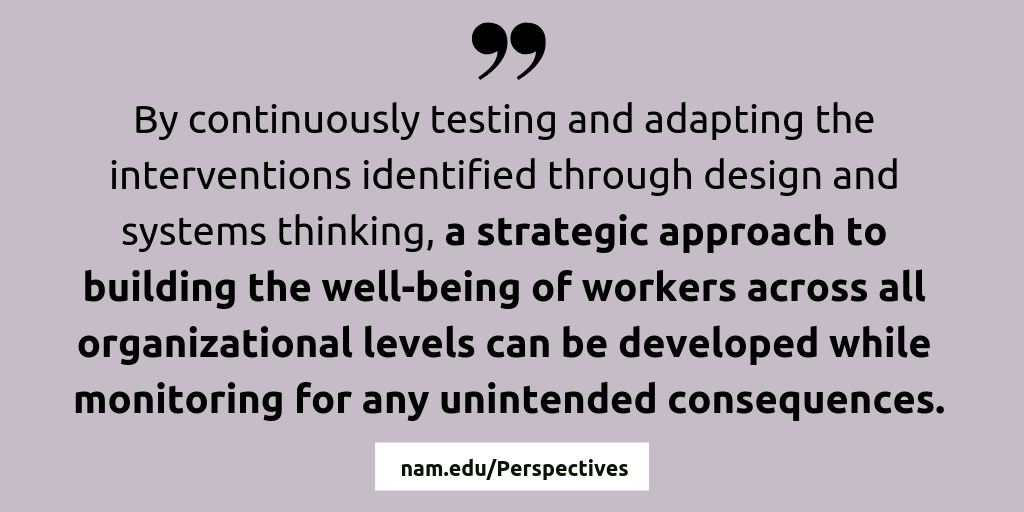Utilizing a Systems and Design Thinking Approach for Improving Well-Being within Health Professions' Education and Health Care
Stress and burnout impact all of the health professions, from education to practice, with potentially serious negative consequences for patients, students, trainees, and health care professionals [1,2]. As a result, organizations are taking action to implement stress reduction and well-being initiatives at their institutions. Some of these interventions take place within the learning environment while others target the practice environment. Despite these laudable efforts, it remains unclear in most instances how each organization developed its plans for selecting a particular intervention and who was engaged in developing the intervention.
This paper highlights two approaches—design thinking and systems thinking—that could be used for developing strategies to address stress and burnout and to improve the well-being of students, trainees, faculty, and health care professionals. The authors further suggest that combining these two approaches may create a more powerful method to examine stress and burnout and the strategies to address both. The paper reviews each approach and then provides an example of what a combined design thinking and systems thinking approach to the reduction of burnout might be like. The authors recognize that this is not the only solution to developing plans to reduce stress and prevent burnout, but hope that presenting this approach might help organizations think about how to address reducing stress and burnout in their workforce.
Design Thinking
Design thinking methods center on carefully listening to all stakeholders prior to developing a solution, and when solutions are being brainstormed, emphasizing creativity. Participants in a design thinking activity are often asked to work with those directly and indirectly affected by a problem to build out an idea stemming from stakeholder conversations and literature searches. The design thinking process starts by asking three related questions [3,4]:
- Desirability—what solution or set of solutions makes sense to people and which are wanted or needed?
- Feasibility—what is functionally possible?
- Viability—what is likely to be sustainable?
After considering these three questions, design thinking uses a multi-step approach to understand the situation, brainstorm solutions, and test and revise the best solution. For example, using design thinking to find solutions for stress and burnout in the health care workforce could involve the following five steps [5]:
- Empathize—Listen to as many voices as necessary to gain a 360-degree perspective on the root causes of stress and burnout, ensuring the inclusion of voices at all career stages and health professions, while conducting a thorough review of the literature.
- Define—After understanding the situation from many different viewpoints, draft a clear statement of the problem and share that draft with all of the stakeholders who were interviewed. Sharing the problem statement ensures that it reflects the ideas put forth during the listening phase. These key stakeholders should have the opportunity to offer input and feedback on the problem statement.
- Ideate—Work with key stakeholders to create a broad range of potential solutions. This is a time for proposing all possible ideas, not for evaluating these ideas.
- Prototype—Ask leading questions (for example, “If we were to assign scribes to reduce administrative tasks, how might that affect both the health care team dynamic and your interactions with the patient?”) to move the group toward a series of potential solutions and to whittle down the larger pool of ideas created in Step 3. In this step, low-fidelity representations of the idea are created and tested through, for example, storyboards, skits, and presentations.
- Test—Share written or designed solutions with stakeholders. After receiving constructive feedback about what is good, what is not, and what can be improved, the intent of this stage is to move the group toward a final design that will need to be monitored and adjusted, as indicated, after it is implemented.
This process, which must be repeated to obtain improved outcomes over time, might engage an expert designer to solicit, facilitate, and incorporate stakeholder input and to identify primary and secondary stakeholders. However, there may also be times when a member of the project team acts as the facilitator of the design process. This person would ensure a deep exploration of the topic and a wide range of stakeholder input before moving to the “Ideate” stage of the process, outlined above. Regardless of which staff are involved in the process, it is critical for the leadership to ensure protected time to undertake the strategic planning or it risks increasing the workload of already overwhelmed employees. It is also critical that the leadership be committed to resourcing solutions after the design process.
Systems Thinking
Systems thinking recognizes that there are often multiple stakeholders or decision makers with potentially conflicting objectives and differing opinions on what a problem is and how to address it [6]. If a decision maker works in isolation to implement a change in one group without consulting others at the organization, it could lead to unforeseen consequences in other parts of the system [7].
Health care is, by its nature, a system of interacting parts. A person’s visit to a health care delivery site will likely involve interactions with providers, administrative staff, facilities maintenance staff, and others. Different workers and units all interact with and affect each other’s work environment and performance. While individual perspectives are important in approaching solutions to complex problems, systems thinking is also a critical viewpoint to bring to problem solving, as it is keenly focused on how the parts of a system work together [8]. For example, a planning process that uses systems thinking would ideally engage individuals from all levels of an organization (e.g., support workers, staff, managers, and leaders) to understand how the different departments (e.g., transportation, housekeeping, clinical, and food service) work together in addition to how each unit functions independently. A variety of tools can be used to visually map out the different connections [9]. This helps stakeholders see how one component of an organization fits within the wider context of a complex structure and how a change in one unit could lead to downstream impacts on other parts of the organization.
Combining Design Thinking with Systems Thinking to Address Health Care Workforce Well-Being
As illustrated above, design thinking and systems thinking both strive to consider the entirety of the system and all stakeholders when developing a solution, so these two approaches can be easily paired. When the creativity and empathy of design thinking is combined with the careful consideration and structural approach of systems thinking, the authors believe that particularly creative, personalized, and well-considered ideas to address stress and well-being naturally emerge. This is a complex undertaking. Such an initiative would have to be balanced with the costs and impacts of such a program on all of its stakeholders, including patients, families, and communities. However, if the program is successful, it will likely create a net financial gain when factoring in the benefits of a healthier workforce due to less worker absenteeism, higher staff retention, diminished burnout among employees, and the impact of a more satisfied workforce on patient safety and satisfaction [10,11].
Conclusion
Using a strategic, collaborative process to identify sources of, and potential solutions to, stress and burnout helps ensure that organizational responses are relevant, effective, and sustainable. The authors believe that design thinking integrated with systems thinking is the most promising way of creating organizational interventions. By continuously testing and adapting the interventions identified through design and systems thinking, a strategic approach to improving the well-being of workers across all organizational levels can be developed while monitoring for any unintended consequences. From students to trainees to health professionals to patients and communities, everyone stands to benefit from a functional health system and a supportive learning environment that emphasizes the well-being of all of its workers and learners while promoting positive engagement with patients, families, and communities.
Join the conversation!
![]() Tweet this! New from @theNAMedicine: Utilizing a Systems and Design Thinking Approach for Improving Well-Being within Health Professions’ Education: https://doi.org/10.31478/201901b #NAMPerspectives
Tweet this! New from @theNAMedicine: Utilizing a Systems and Design Thinking Approach for Improving Well-Being within Health Professions’ Education: https://doi.org/10.31478/201901b #NAMPerspectives
![]() Tweet this! Burnout impacts all health professionals, from administrative staff to nurses to clinicians to CEOs. Therefore, it is critical to involve all of their voices in developing strategies to improve well-being: https://doi.org/10.31478/201901b #NAMPerspectives
Tweet this! Burnout impacts all health professionals, from administrative staff to nurses to clinicians to CEOs. Therefore, it is critical to involve all of their voices in developing strategies to improve well-being: https://doi.org/10.31478/201901b #NAMPerspectives
![]() Tweet this! Reducing burnout in health care professionals is challenging. Combining systems and design thinking may be a promising path forward: https://doi.org/10.31478/201901b #NAMPerspectives
Tweet this! Reducing burnout in health care professionals is challenging. Combining systems and design thinking may be a promising path forward: https://doi.org/10.31478/201901b #NAMPerspectives
Download the graphics below and share them on social media!


References
- Kreitzer, M. J. 2015. The Wellbeing of the workforce–In healthcare and beyond. Global Advances in Health and Medicine 4(5):3–4. https://doi.org/10.7453/gahmj.2015.082
- Coffey, D. S., K. Eliot, E. Goldblatt, C. Grus, S. P. Kishore, M. E. Mancini, R. Valachovic, and P. Hinton Walker. 2017. A Multifaceted Systems Approach to Addressing Stress Within Health Professions Education and Beyond. NAM Perspectives. Discussion Paper, National Academy of Medicine, Washington, DC. https://doi.org/10.31478/201701e
- Brown, T. 2009. Change by design: How design thinking transforms organizations and inspires innovation. New York: HarperCollins.
- Rodgers, P., and E. Winton. 2010. Design thinking—a critical analysis. In Proceedings of E&PDE 2010, the 12th International Conference on Engineering and Product Design Education—When Design Education and Design Research Meet, Trondheim, Norway, September 2–3, 2010.
- Plattner, H. An introduction to design thinking: Process guide. Stanford, CA: Hasso Plattner Institute of Design at Stanford University.
- Manley, K., A. Martin, C. Jackson, and T. Wright. 2016. Using systems thinking to identify workforce enablers for a whole systems approach to urgent and emergency care delivery: A multiple case study. BMC Health Services Research 16(1):368. https://doi.org/10.1186/s12913-016-1616-y
- Wiedemann, L. A. 2012. A look at unintended consequences of EHRs. Health Management Technology. Available at: https://www.healthmgttech.com/a-look-at-unintended-consequences-of-ehrs.php (accessed September 2, 2020).
- Pourdehnad, J., E. R. Wexler, and D. V. Wilson. 2011. Systems & design thinking: A conceptual framework for their integration. Organizational Dynamics Working Papers. Available at: http://repository.upenn.edu/od_working_papers/10 (accessed September 2, 2020).
- Vats, A., K. H. Goin, M. C. Villarreal, T. Yilmaz, J. D. Fortenberry, and P. Keskinocak. 2012. The impact of a lean rounding process in a pediatric intensive care unit. Critical Care Medicine 40(2):608–617. https://doi.org/10.1097/CCM.0b013e318232e2fc
- Litchfield, P., C. Cooper, C. Hancock, and P. Watt. 2016. Work and wellbeing in the 21st Century. International Journal of Environmental Research and Public Health 13(11):1065. https://doi.org/10.3390/ijerph13111065
- Pronk, N. P. 2014. Placing workplace wellness in proper context: Value beyond money. Preventing Chronic Disease 11:E119. https://doi.org/10.5888/pcd11.140128


